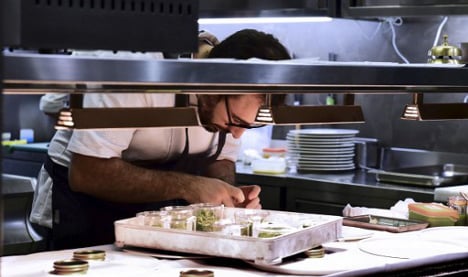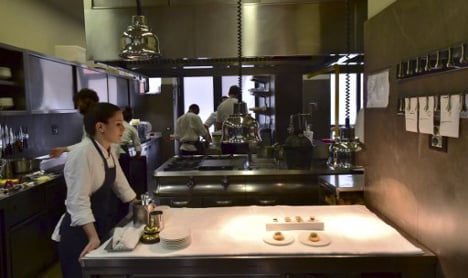But as part of his ongoing project to eliminate food waste and help tackle social issues through food, Bottura is currently working in Rio de Janeiro, serving meals to the homeless.
The restaurant, Refettorio Gastromotiva, is housed in a building made of corrugated plastic in a lot in the city's Lapa district; its customers are members of Rio's large homeless population.
Meals are made from leftovers from caterers working at the Olympics and other local businesses, with filling, healthy dishes on the menu including aubergine parmigiana and a twist on classic carbonara which used banana skins, La Repubblica reported.
The project is the result of a collaboration between Bottura himself, whose social organization Food for Soul aims to eliminate food waste and build community, and Brazilian chef David Hertz, who runs the non-profit organization, Gastromotiva, to promote social integration.

Photo: Giuseppe Cacace/AFP
Around 5,000 meals a day are prepared both by top international chefs, and graduates of Gastromotiva's cooking school, which teaches people from Brazil's neglected favelas how to cook. The restaurant will stay open throughout the Olympic and Paralympic Games, after which it will become a social project.
Bottura says his inspiration comes from Pope Francis's dedication to help the poor, and he was involved in a similar project providing food to the homeless during Milan's Expo last year, which saw an abandoned theatre on the city's outskirts transformed into a kitchen.
Bottura's Modena-based restaurant, The Osteria Francescana, was crowned the best eatery in the world in this year's prestigious World's 50 Best Restaurants Awards. The restaurant also boasts three Michelin stars and a meal doesn't come cheap, with the tasting menu setting diners back €220.
READ MORE: Meet the Italian genius behind the world's best restaurant
His dishes, including 'Yellow is bello' and 'Memory of a mortadella sandwich', offer a creative twist on traditional Italian cuisine, and Bottura doesn't take himself too seriously. He also devotes a lot of time to social projects around eliminating food waste, an issue which has become a hot topic in Italy recently.
 Photo: Giuseppe Cacace/AFP
Photo: Giuseppe Cacace/AFP
Earlier this month, Italy introduced a set of laws aimed at eliminating unnecessary food waste by incentivizing shops and restaurants to give away food waste for free. Donating food which has passed its official sell-by date has been made easier, and a €1 million campaign has been rolled out to encourage the use of 'doggy bags' in restaurants.
A study by the University of Bologna earlier this year suggested that the food wasted by Italian households and businesses amounts to some €13 billion each year, equivalent to 1.1 percent of the country's GDP.




 Please whitelist us to continue reading.
Please whitelist us to continue reading.
Member comments